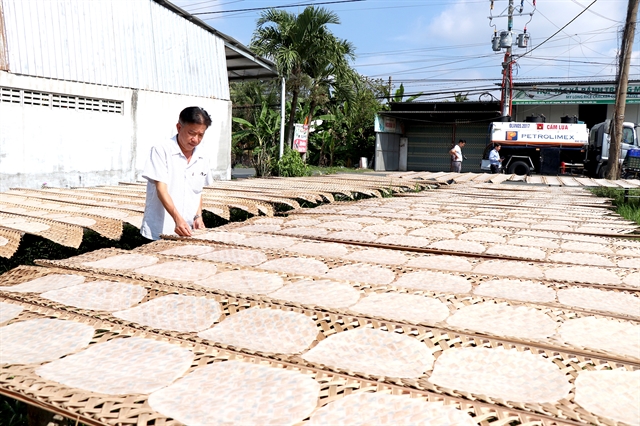 Society
Society

 |
| Nguyễn Thanh Huy examines rice paper sheets drying in the sun. — VNA/VNS Photo |
BẾN TRE — Rice paper makers in a southern commune are working at full tilt to keep up with a pre-Tết surge in demand.
Mỹ Thạnh Commune in Giồng Tôm District, Bến Tre Province, has a well-established tradition of rice paper making dating back over a century.
For Nguyễn Thanh Huy, a rice paper maker, the weeks leading up to Tết are the busiest of the year. His family begins work at 1am every day, producing around 700 sheets to meet the rising demand.
The task is labour-intensive. It requires careful mixing of rice flour, coconut milk and sesame seeds before the thin batter is spread, steamed and left to dry under the sun.
"This job doesn’t make us rich, but it’s been passed down through generations in our family," Huy said. "We’re proud to contribute to the festive atmosphere of Tết with our work.”
Rice paper in Mỹ Thạnh, often referred to as 'Mỹ Lồng rice paper', is highly regarded for its quality and flavour. During Tết, demand spikes as people stock up for feasts and celebrations.
But the once-thriving industry is facing mounting challenges. Just a few years ago, Mỹ Thạnh had 211 families involved in production, employing approximately 500 workers.
This year, that number has dropped to 60 families. Rising input costs, particularly for coconuts, a key ingredient, have squeezed profits. Coconut prices have nearly doubled compared to last year, leaving many operating on razor-thin margins.
"We’re barely making a profit," said Nguyễn Thanh Tùng, a veteran rice paper maker with over 50 years of experience. "In the past, this was a lucrative trade. Now, we’re just working to preserve our traditions."
Tùng, like many others, has scaled back production, focusing on supplying loyal customers. He says makers are now in a situation of "taking labour as profit," as rising costs leave little room for earnings.
Despite the challenges, rice paper remains a sought-after product during the holiday season. Each family typically produces between 25,000 and 90,000 sheets in the weeks prior to Tết.
Most are sold to customers in Việt Nam’s central and southern regions, while a portion is shipped abroad to Vietnamese communities overseas.
However, supply often falls short of demand. Makers prioritise pre-orders, and those without contracts are left waiting. "We simply can’t keep up," Huy said, noting that orders come in faster than they can fulfil them.
Recognising the cultural significance of Mỹ Lồng rice paper, local authorities have stepped in to support the industry.
The craft has been officially recognised as an intangible cultural heritage of Việt Nam, and the Mỹ Lồng Rice Paper Co-operative has received three-star OCOP certification, a designation for high-quality rural products.
Ngô Tấn Quyền, Chairman of Mỹ Thạnh People's Committee, said the Government is working to modernise production and expand the industry’s reach.
"We are supporting makers with improved equipment, better packaging and marketing strategies to boost competitiveness," he said.
In recent years, provincial funding has helped a handful of families transition to industrial methods, significantly increasing productivity.
The commune also offers financial assistance of up to VNĐ50 million ($1,975) per family to help them secure raw materials in advance, avoiding price hikes during the peak season.
For many, rice paper is more than just a livelihood — it’s a source of pride and identity.
"When we see our rice paper drying under the sun during Tết, it reminds us of the joy this craft brings to our community," Huy said. — VNS




